Economic Assessment of Hydrologic Ecosystem Services in Morocco’s Protected Areas: A Case Study of Ifrane National Park
Abstract
:1. Introduction
2. Materials and Methods
2.1. Study Area
2.2. Methods
2.2.1. Quantification Methods
2.2.2. Economic Valuation Methods
- A.
- Market Price Method
- B.
- Damage Costs Avoided Method
- -
- r: Relative decrease in yield due to erosion (%).
- -
- EwP: Erosion rate (t/ha/year).
- -
- ∆R: Relative decrease in yield due to erosion (t/ha);
- -
- r: Relative decrease in yield due to erosion (%).
3. Results
3.1. Land Use Dynamic in INP
3.2. Economic Value of Sediment and Nutrient Retention
Evaluation of On-Site Effects (Cost of Avoided Forage and Crop Yield Losses)
- A.
- Avoided loss of agricultural yields
- B.
- Avoided loss in forage yields
- C.
- Assessment of offsite effects
- D.
- Water Quality Loss
- E.
- Evaluation of Mobilizing Water Lost through Siltation Cost
3.3. Economic Value of Water Yield
4. Discussion
5. Conclusions
Author Contributions
Funding
Institutional Review Board Statement
Informed Consent Statement
Data Availability Statement
Conflicts of Interest
Appendix A. InVEST Model Inputs
- InVEST models input rasters.
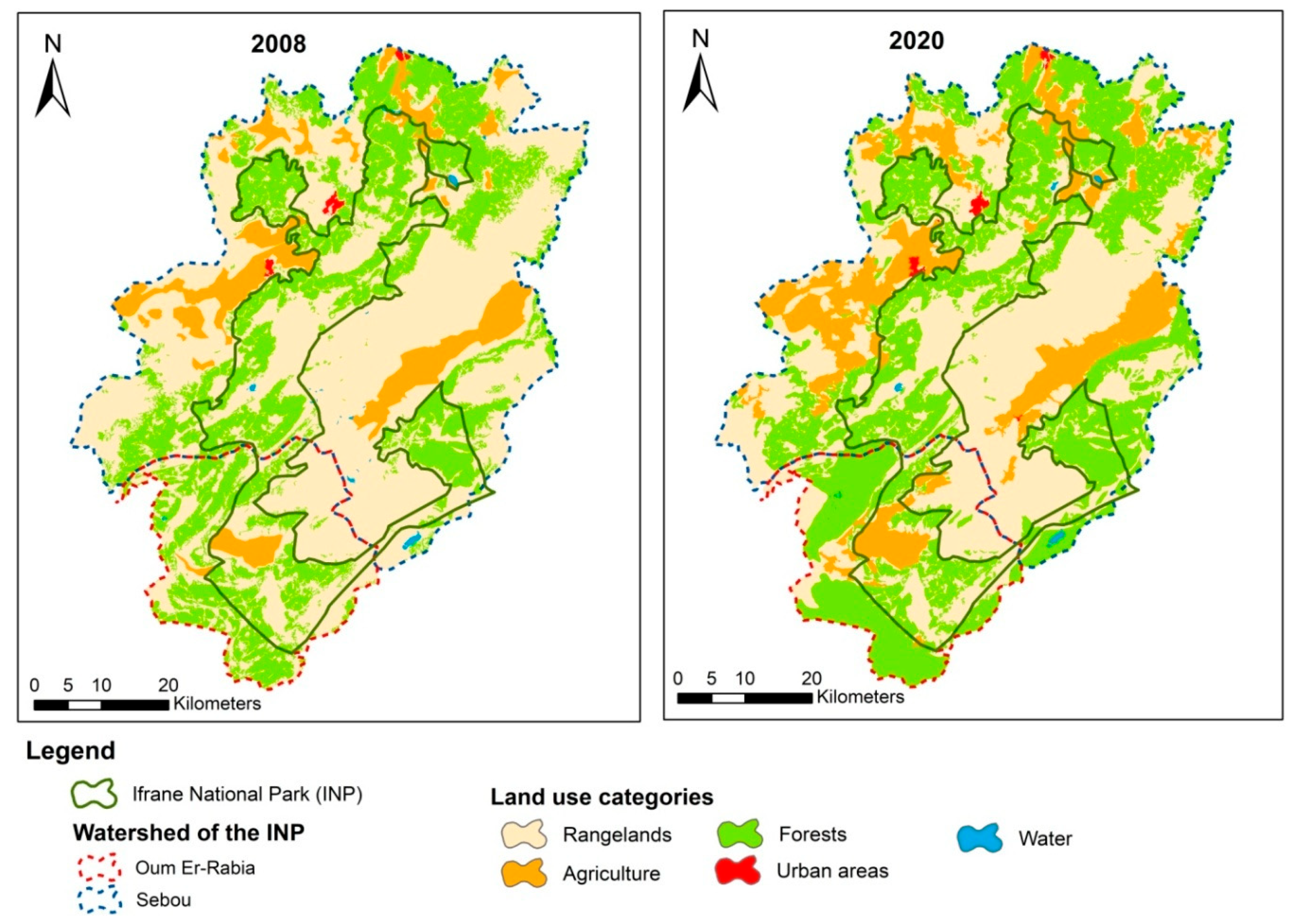

| LULC_desc | Lucode | Usle_c | Usle_p |
|---|---|---|---|
| Rangelands | 1 | 1 | 1 |
| Forests | 2 | 0.003 | 1 |
| Agriculture | 3 | 0.19 | 1 |
| Urban areas | 4 | 0.1 | 1 |
| Water | 5 | 0.04 | 1 |
- -
- usle_c: Cover management factor for the USLE;
- -
- usle_p: Support practice factor for the USLE.
| LULC_desc | lucode | Load_n | Eff_n | Load_p | Eff_p | crit_len_p | crit_len_n |
|---|---|---|---|---|---|---|---|
| Rangelands | 1 | 4.84 | 0.305 | 0.292 | 0.25 | 150 | 150 |
| Forests | 2 | 2.89 | 0.8 | 0.07 | 0.74 | 150 | 150 |
| Agriculture | 3 | 7.4 | 0.69 | 1.305 | 0.59 | 150 | 150 |
| Urban areas | 4 | 11.86 | 0.43 | 2.55 | 0.02 | 150 | 150 |
| water | 5 | 0 | 0.06 | 0 | 0.61 | 150 | 150 |
- -
- load_[NUTRIENT]: The nutrient loading for this land use class;
- -
- eff_[NUTRIENT]: The maximum proportion of the nutrient that is retained on this land use class;
- -
- crit_len_[NUTRIENT]: The distance after which it is assumed that this land use type retains the nutrient at its maximum capacity;
- -
- InVEST’s “Water yield” model.
| LULC_desc | lucode | LULC_veg | Root_depth (mm) | Kc |
|---|---|---|---|---|
| Rangelands | 1 | 1 | 830 | 0.36 |
| Forests | 2 | 1 | 4000 | 1 |
| Agriculture | 3 | 1 | 1473 | 1.12 |
| Urban areas | 4 | 0 | 1000 | 0.4 |
| Water | 5 | 0 | 1 | 1 |
- -
- Lulc_veg: Code indicating whether the land use class is vegetated for the purpose of AET;
- -
- root_depth: Maximum root depth for plants in this land use class;
- -
- Kc: Crop coefficient for this land use class. Used to calculate potential evapotranspiration to modify the reference evapotranspiration.
References
- John, C.M. Biodiversity Conservation Through Protected Areas Supports Healthy Ecosystems and Resilience to Climate Change and Other Disturbances. Imperiled Encycl. Conserv. 2022, 423–429. [Google Scholar]
- Chape, S.; Spalding, M.; Jenkins, M. (Eds.) The World’s Protected Areas: Status, Values and Prospects in the 21st Century; Universidad de Castilla La Mancha: Ciudad Real, Spain, 2008. [Google Scholar]
- Brauman, K.A.; Daily, G.C.; Duarte, T.K.E.; Mooney, H.A. The nature and value of ecosystem services: An overview highlighting hydrologic services. Annu. Rev. Environ. Resour 2007, 32, 67–98. [Google Scholar] [CrossRef]
- Abell, R.; Allan, J.D.; Lehner, B. Unlocking the potential of protected areas for freshwaters. Biol. Conserv. 2007, 134, 48–63. [Google Scholar] [CrossRef]
- Kumar, P. (Ed.) The Economics of Ecosystems and Biodiversity: Ecological and Economic Foundations; Routledge: New York, NY, USA, 2012. [Google Scholar]
- Tinch, R.; Beaumont, N.; Sunderland, T.; Ozdemiroglu, E.; Barton, D.; Bowe, C.; Börger, T.; Burgess, P.; Cooper, C.N.; Faccioli, M.; et al. Economic valuation of ecosystem goods and services: A review for decision makers. J. Environ. Econ. Policy 2019, 8, 359–378. [Google Scholar] [CrossRef]
- Sheergojri, I.A.; Rashid, I. Systematic review of wetland ecosystem services valuation in India: Assessing economic approaches, knowledge gaps, and management implications. J. Environ. Stud. Sci. 2023, 8, 359–378. [Google Scholar] [CrossRef]
- Costanza, R.; d’Arge, R.; De Groot, R.; Farber, S.; Grasso, M.; Hannon, B.; Limburg, K.; Naeem, S.; O’Neill, R.V.; Paruelo, J.; et al. The value of the world’s ecosystem services and natural capital. Nature 1997, 387, 253–260. [Google Scholar] [CrossRef]
- Turpie, J.K.; Marais, C.; Blignaut, J.N. The working for water programme: Evolution of a payments for ecosystem services mechanism that addresses both poverty and ecosystem service delivery in South Africa. Ecol. Econ. 2008, 65, 788–798. [Google Scholar] [CrossRef]
- Chillasse, L.; Dakki, M.; Abbassi, M.; Agdal, R. Valeurs et fonctions écologiques des Zones humides du Moyen Atlas (Maroc). Humed. Mediterráneos 2001, 1, 139–146. [Google Scholar]
- Touabay, M.; Aouad, N.; Mathieu, J. Etude hydrobiologique d’un cours d’eau du Moyen-Atlas: L’oued Tizguit (Maroc). Ann. Limnol. Int. J. Limnol. 2002, 38, 65–80. [Google Scholar] [CrossRef]
- Milian, J. Le dilemme entre développement et protection dans les montagnes du Maroc-le cas des parcs du Moyen Atlas. Géocarrefour 2007, 82, 177–186. [Google Scholar] [CrossRef]
- Abd Elbasit, M.A.M.; Knight, J.; Liu, G.; Abu-Zreig, M.M.; Hasaan, R. Valuation of Ecosystem Services in South Africa, 2001–2019. Sustainability 2021, 13, 11262. [Google Scholar] [CrossRef]
- Azadi, H.; Van Passel, S.; Cools, J. Rapid economic valuation of ecosystem services in man and biosphere reserves in Africa: A review. Glob. Ecol. Conserv. 2021, 28, e01697. [Google Scholar] [CrossRef]
- Jamouli, A.; Allali, K. Economic valuation of ecosystem services in Africa. In E3S Web of Conferences; EDP Sciences: Les Ulis, France, 2020; p. 01002. [Google Scholar]
- Pettinotti, L.; De Ayala, A.; Ojea, E. Benefits from water-related ecosystem services in Africa and climate change. Ecol. Econ. 2018, 149, 294–305. [Google Scholar] [CrossRef]
- Measho, S.; Chen, B.; Pellikka, P.; Trisurat, Y.; Guo, L.; Sun, S.; Zhang, H. Land use/land cover changes and associated impacts on water yield availability and variations in the Mereb-Gash River Basin in the Horn of Africa. J. Geophys. Res. Biogeosci. 2020, 125. [Google Scholar] [CrossRef]
- Arowolo, A.O.; Deng, X.; Olatunji, O.A.; Obayelu, A.E. Assessing changes in the value of ecosystem services in response to land-use/land-cover dynamics in Nigeria. Sci. Total Environ. 2018, 636, 597–609. [Google Scholar] [CrossRef]
- Du Toit, M.J.; Cilliers, S.S.; Dallimer, M.; Goddard, M.; Guenat, S.; Cornelius, S.F. Urban green infrastructure and ecosystem services in sub-Saharan Africa. Landsc. Urban Plan. 2018, 180, 249–261. [Google Scholar] [CrossRef]
- Leh, M.D.K.; Matlock, M.D.; Cummings, E.C.; Nalley, L.L. Quantifying and mapping multiple ecosystem services change in West Africa. Agric. Ecosyst. Environ. 2013, 165, 6–18. [Google Scholar] [CrossRef]
- Hamid, M.L.A. Economic Evaluation of Ecosystem Services Provided by Marine Protected Areas in West Africa: The Case of Banc d’Arguin National Park-Mauritania. PhD Thesis, University of Montpellier, Montpellier, France, 2018. [Google Scholar]
- Daly Hassen, H. Estimation of the Economic and Social Value of Goods and Services Provided by Mediterranean Forest Ecosystems: A Critical and Comparative Analysis of Studies in Algeria, Lebanon, Morocco, Tunisia, and Turkey. Plan Bleu 2016, Valbonne, 1–41. [Google Scholar]
- Kusi, K.K.; Khattabi, A.; Mhammdi, N.; Lahssini, S. Prospective evaluation of the impact of land use change on ecosystem services in the Ourika watershed, Morocco. Land Use Policy 2020, 97, 104796. [Google Scholar] [CrossRef]
- Kusi, K.K.; Khattabi, A.; et Mhammdi, N. Integrated assessment of ecosystem services in response to land use change and management activities in Morocco. Arab. J. Geosci. 2021, 14, 418. [Google Scholar] [CrossRef]
- Kusi, K.K.; Khattabi, A.; et Mhammdi, N. Analyzing the impact of land use change on ecosystem service value in the main watersheds of Morocco. Environ. Dev. Sustain. 2022, 25. [Google Scholar] [CrossRef]
- Department of Water and Forests/DREFLCD—Middle Atlas. Master Plan for the Development and Management of Ifrane National Park; Internal document; Department of Water and Forests/DREFLCD: Tetuan, Morroco, 2007; pp. 1–180. [Google Scholar]
- Achehboune, M.J. Etat Actuel du Dépérissement du Cèdre de l’Atlas au Moyen Atlas Central en Relation Avec la Station et la Sylviculture, Cas des Forêts: JbelAoua Sud et Ait Youssfi de l’Amekla (Canton de LallaMimouna). Ph.D. Thesis, 3rd Cycle National Forest Engineering School, Salé, Morocco, 2006; 137p. [Google Scholar]
- Naturel Capital Project. Invest User Guide_Invest documentation. Available online: http://releases.naturalcapitalproject.org/invest-userguide/latest/index.html (accessed on 10 November 2020).
- Achiban, H.; Taous, A.; El-Khantoury, I.; el Mderssa, M.; et Amechrouq, A. Quantification of soil loss in various lithological areas of the western Middle Atlas Central: Application to the Ras-Elma, Tamelalet and Sebab watershed (Tigrigra watershed, Morocco). In E3S Web of Conferences; EDP Sciences: Les Ulis, France, 2018; Volume 37, p. 04003. [Google Scholar]
- Benez-Secanho, F.J.; Dwivedi, P. Does quantification of ecosystem services depend upon scale (Resolution and Extent)? A case study using the invest nutrient delivery ratio model in Georgia, United States. Environments 2019, 6, 52. [Google Scholar] [CrossRef]
- Rango, A.; Arnoldus, H.M.J. Aménagement des bassins versants. Cah. Tech. FAO 1987, 36, 1–11. [Google Scholar]
- Aoubouazza, M. Estimation des besoins en eau du Cèdre à Ras El Ma et à Boutrouba (Moyen Atlas Central tabulaire). Rev. Marocaine Sci. Agron. Vétér. 2018, 6, 36–47. [Google Scholar]
- Carson, R.T.; Flores, N.E.; Martin, K.M.; Wright, J.L. Contingent valuation and revealed preference methodologies: Comparing the estimates for quasi-public goods. Land Econ. 1996, 72, 80–99. [Google Scholar] [CrossRef]
- Christie, M.; Fazey, I.; Cooper, R.; Hyde, T.; Kenter, J.O. An evaluation of monetary and non-monetary techniques for assessing the importance of biodiversity and ecosystem services to people in countries with developing economies. Ecol. Econ. 2012, 83, 67–78. [Google Scholar] [CrossRef]
- Pearce, D. Economics of natural resources and the environment/DW Pearce, RK Turner. Am. J. Agr. Econ. 1991, 73, 1242904. [Google Scholar]
- Den Biggelaar, C.; Lal, R.; Wiebe, K.; Breneman, V. The global impact of soil erosion on productivity. I. Absolute and relative erosion-induced yield losses. Adv. Agron. 2004, 81, 1–48. [Google Scholar]
- Jorio, A. Le Coût de la Dégradation de l’Environnement au Maroc. Chapitre 5 “Sols”. Environment and Natural Resources Global Practice Discussion Paper; World Bank Group Report 105633-MA; World Bank: New York, NY, USA, 2017; pp. 49–64. [Google Scholar]
- Khattabi, A.; Croitoru, L. Le Coût de la Dégradation de l’Environnement au Maroc. Chapitre 3 “Eau”. Environment and Natural Resources Global Practice Discussion Paper; World Bank Group Report 105633-MA; World Bank: New York, NY, USA, 2017; pp. 13–35. [Google Scholar]
- National Office of Electricity and Drinking Water—Midelt. Weekly Treatment Products Ratio; Internal document; National Office of Electricity and Drinking Water: Casablanca, Morocco, 2019. [Google Scholar]
- ABH Oum Er Rbia. Fees for the Use of Public Hydraulic Domain; Internal document; Agence du bassin hydraulique de l’Oum Er Rbia: Beni Mellal, Morroco, 2020. [Google Scholar]
- Department of Water and Forests/DREFLCD—Ifrane. Forest Fires in the Province of Ifrane; Internal document; Department of Water and Forests/DREFLCD: Tetuan, Morroco, 2020. [Google Scholar]
- Department of Water and Forests/DREFLCD—Ifrane. Final Report on Reforestation in the Province of Ifrane; Internal document; Department of Water and Forests/DREFLCD: Tetuan, Morroco, 2020. [Google Scholar]
- Department of Water and Forests/DREFLCD—Ifrane. Number of AGS and Compensated Defense Area; Internal document; Department of Water and Forests/DREFLCD: Tetuan, Morroco, 2020. [Google Scholar]
- Hamzaoui, I.; Gmira, N.; Qarro, M. Sedentarization of Pastoralists and Impacts on the Sustainability of Forest Ecosystems in the Central Middle Atlas (Case of the Province of Ifrane, Morocco). Nat. Technol. 2020, 12, 38–46. [Google Scholar]
- Laouina, A. Sustainable Land Management in Mountain Areas and Risk Reduction Downstream: The Moroccan Case. Bull. Séanc. Acad. R. Sci. Outre-Mer 2019, 2019, 203–223. [Google Scholar]
- Etebaai, I.; Damnati, B.; Raddad, H.; Benhardouz, H.; Benhardouz, O.; Miche, H.; Taieb, M. Climate and Anthropogenic Impacts on the Hydrogeochemical Functioning of Lake Ifrah (Moroccan Middle Atlas). Hydrol. Sci. J. 2012, 57, 547–561. [Google Scholar] [CrossRef]
- Qadem, A.; Akdim, B.; Laaouane, M.; Lebaut, S.; Gille, E. Use and Management of Water Resources in Upper Sebou (Middle Atlas, Morocco). Geomaghreb Rev. Appl. Stud. Earth Sci. Geogr. Plan. 2014, 10, 21–32. [Google Scholar]
- FAO. What Happens to Infiltration Water in the Soil? Available online: https://www.fao.org/fishery/en/ (accessed on 15 May 2021).
- Cosandey, C. Does the Forest Reduce Annual Runoff? In Annales de Géographie; Armand Colin: Paris, France, 1995; pp. 7–25. [Google Scholar]


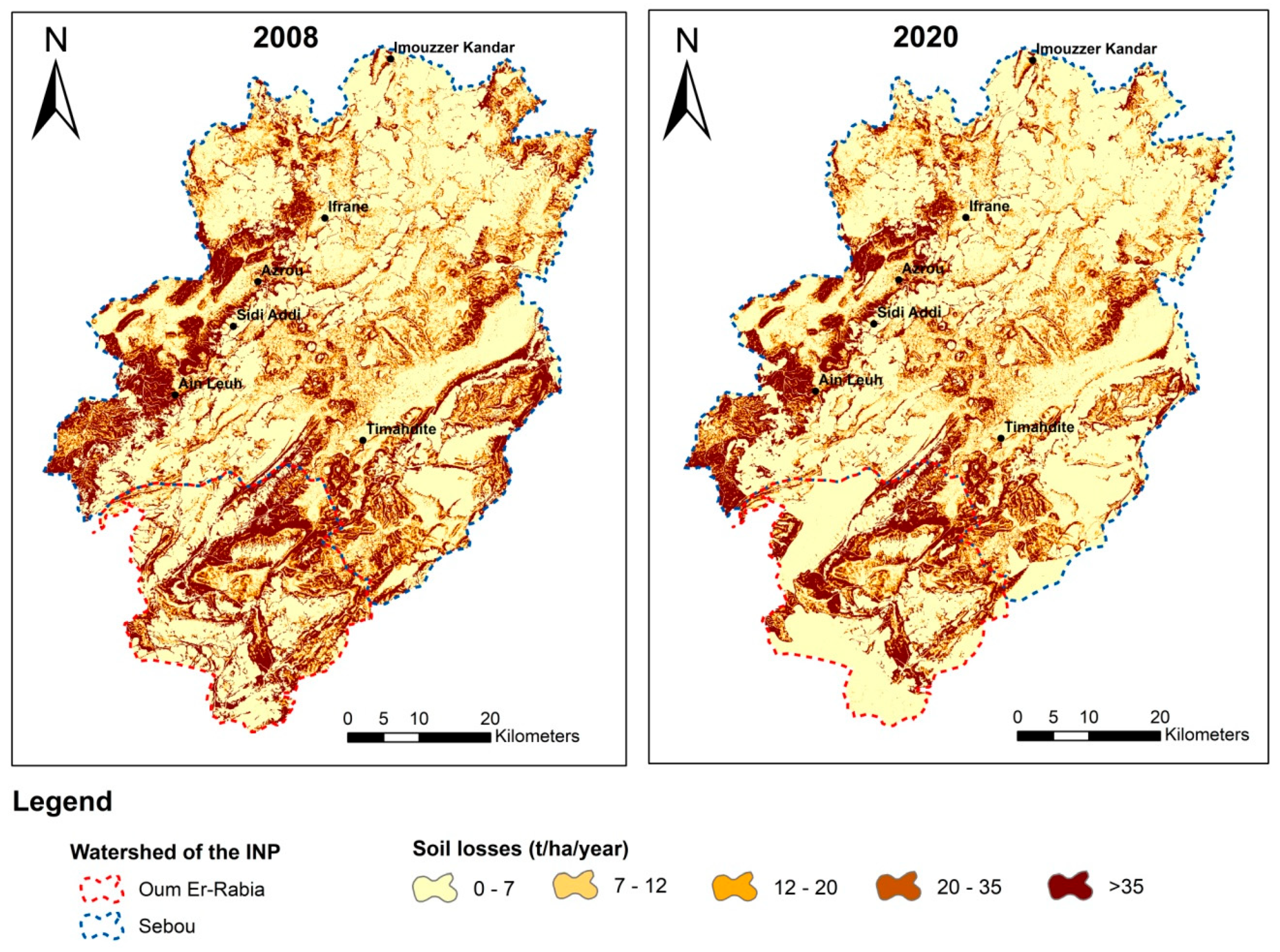
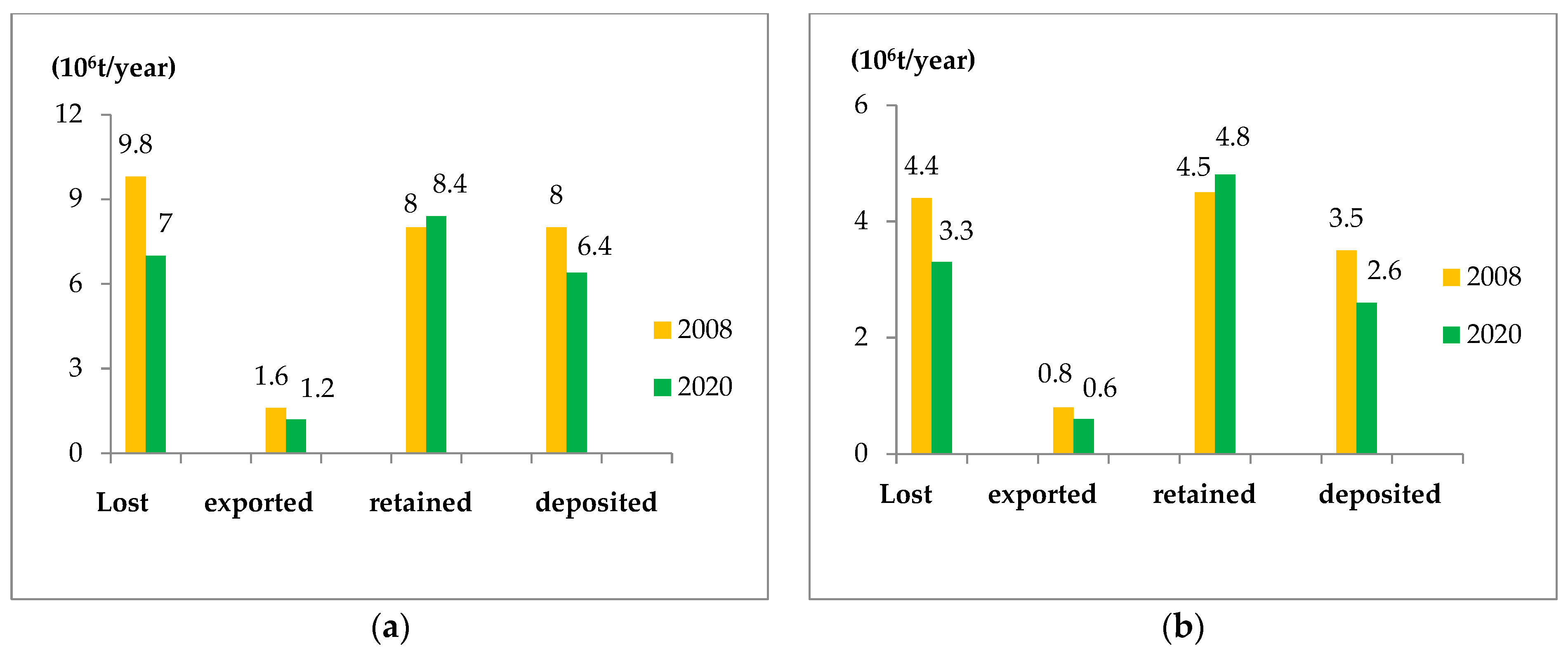

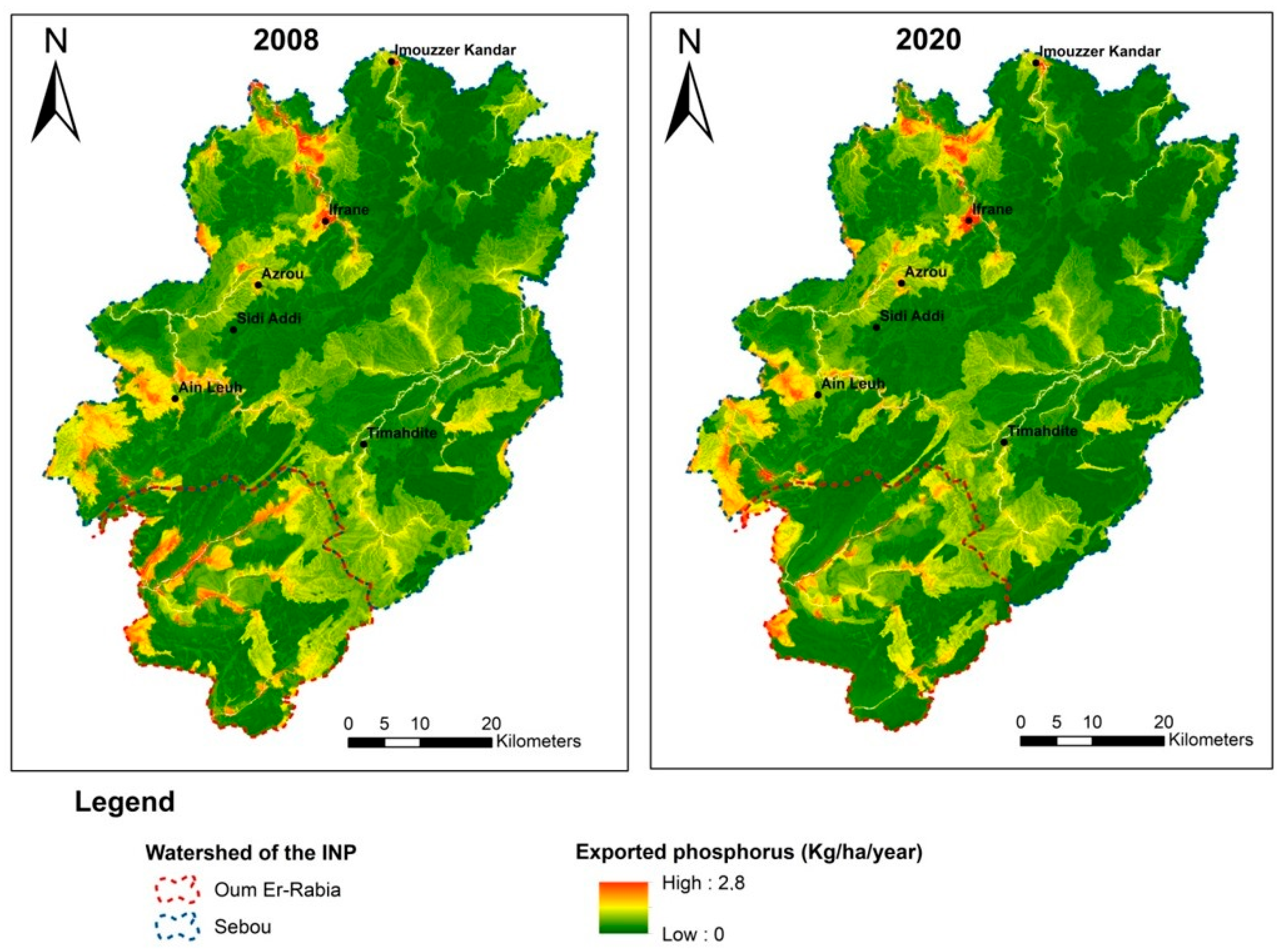
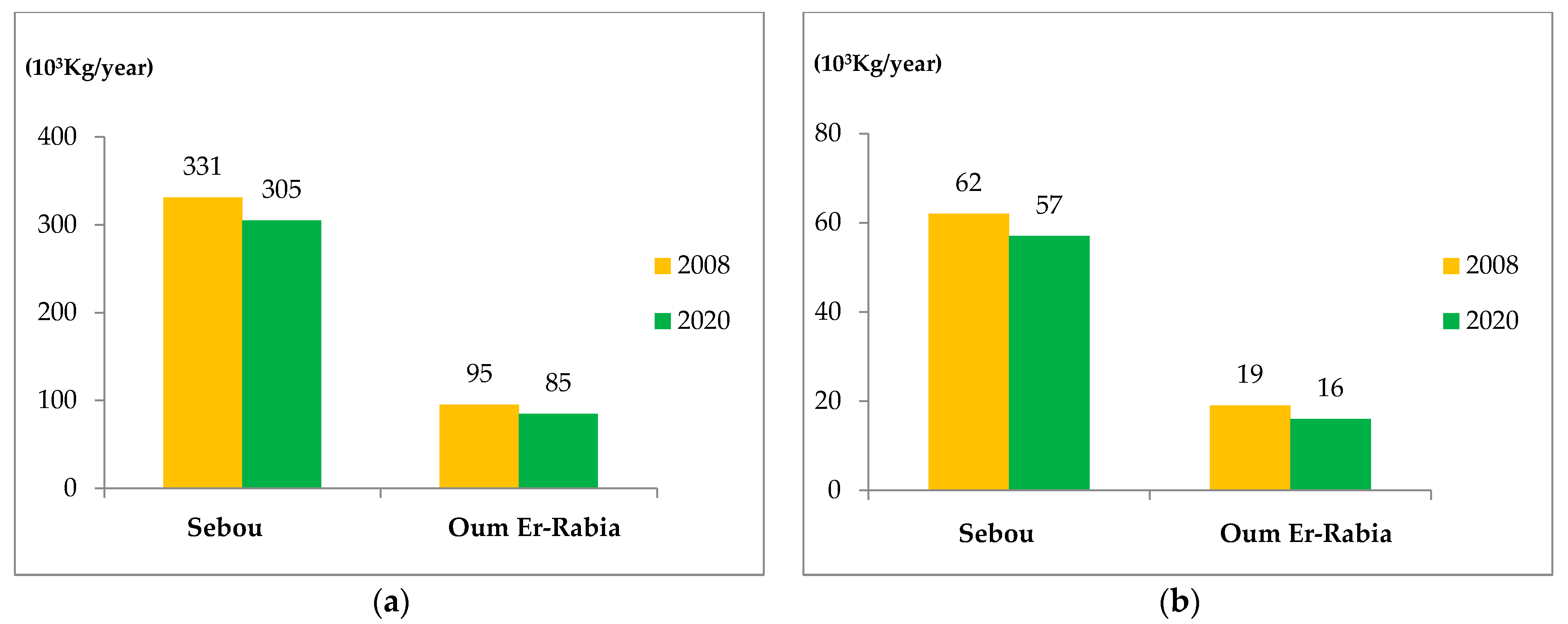

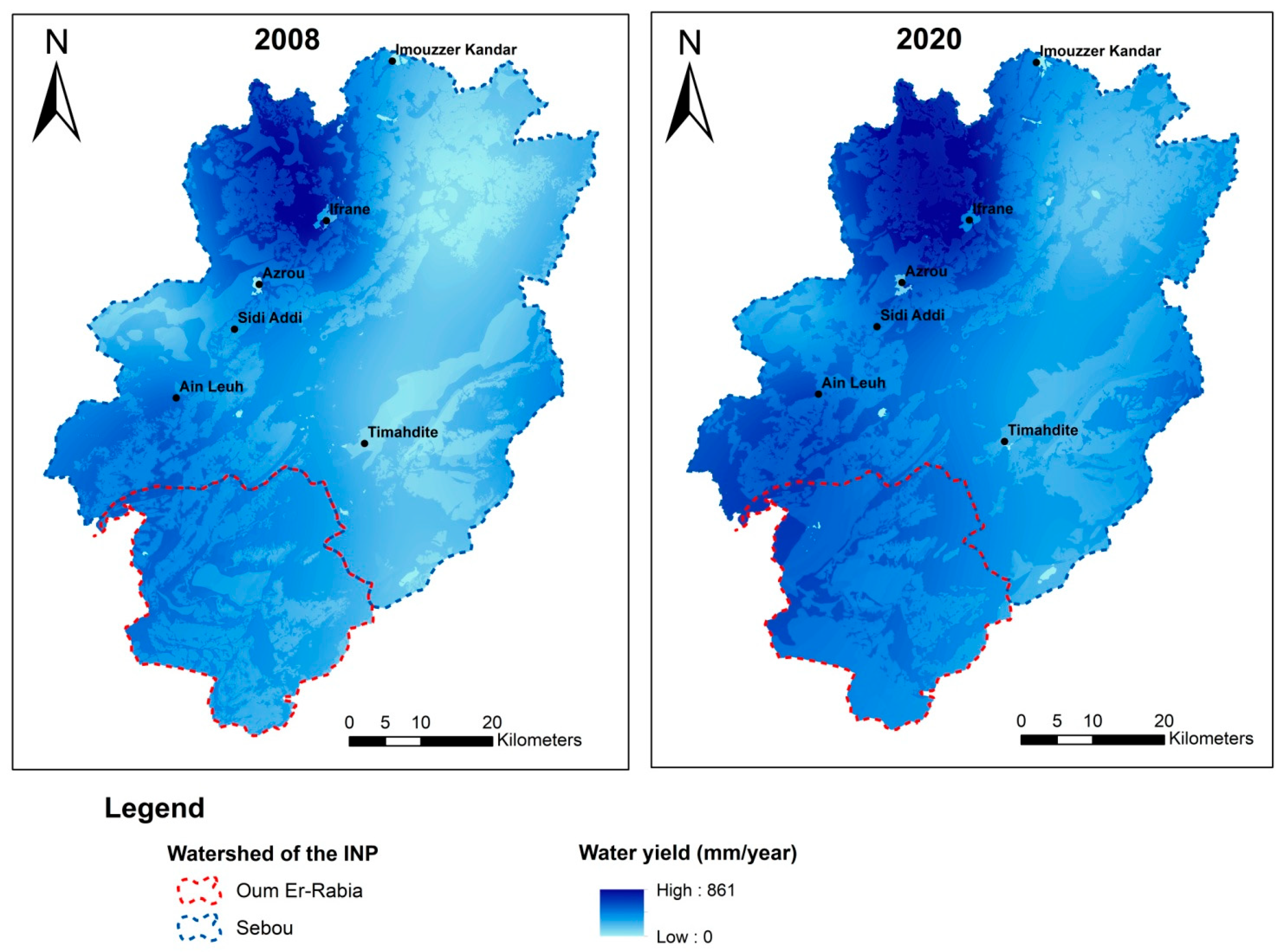

| HES Studied | Quantification Method | Economic Valuation Method |
|---|---|---|
| Erosion control | InVEST’s “Sediment Delivery Ratio” model | Damage costs avoided |
| Water purification | InVEST’s “Nutrient Delivery Ratio” model | |
| Water yield | InVEST’s “Annual Water Yield” model | Market price |
| Inputs (*) | InVEST Models | Source of Inputs |
|---|---|---|
| Land use raster | All InVEST models | Obtained by digitizing, using Google Earth images |
| Biophysical tables | All InVEST models | From literature [25,29,30] |
| Rasters of climatic data (precipitation and evapotranspiration) | “Sediment Delivery Ratio” “Nutrient Delivery Ratio” “Water Yield” | Obtained from the measurements of the weather stations covering the study area, and from: https://climate.northwestknowledge.net/ (accessed on 29 March 2021) |
| Digital Elevation Model | “Sediment Delivery Ratio” “Nutrient Delivery Ratio” “Water Yield” | From the Earth Data website of the National Aeronautics and Space Administration of the United States of America (https://earthdata.nasa.gov (accessed on 20 April 2021)) |
| Erosivity raster (R Factor) | “Sediment Delivery Ratio” | Calculated from annual and monthly precipitation averages over a 30-year period (1985–2015), using the formula of Rango and Arnoldus (1987) [31] |
| Soil erodibility raster (K factor) | Obtained by assigning the corresponding K-factor values [29] to the lithologic facies of the study area | |
| Roots depth raster | “Water Yield” | Obtained by granting each land use the corresponding root depth |
| Plants’ Available Water Content | Obtained by assigning the corresponding plant’s available water content values [32] to the lithologic facies of the study area |
| Erosion Classes (t/ha/year) | Erosion Intensity | Loss of Forage Productivity (%) |
|---|---|---|
| 0–5 | Very low | 2.5 |
| 5–25 | Low and medium | 25 |
| >25 | Strong and very strong | 45 |
| Soil Loss Class (t/ha/year) | Area in 2008 (ha) | Area in 2020 (ha) | The Difference (ha) | The Difference (ha/year) |
|---|---|---|---|---|
| 0–7 | 2198.2 | 3116.9 | +918.7 | +76.5 |
| 7–12 | 658.1 | 897.5 | +239.4 | +19.9 |
| 12–20 | 612.6 | 988.4 | +375.7 | +31.3 |
| 20–35 | 618.5 | 1194.3 | +575.7 | +47.9 |
| >35 | 738.2 | 2477.8 | +1739.6 | +144.9 |
| Total | 4825.7 | 8674.9 | +3849.3 | +320.7 |
| Soil Loss Class (t/ha/year) | Erosion Rate Ewp (t/ha/year) | Decrease in Yield: r (%) | Decline in Yield (*) ∆R = rxAverage Yield (2.44 t/Ha) (t/ha) | Price (USD/ha) | Annual Cost of Erosion (USD/year) |
|---|---|---|---|---|---|
| 0–7 | 3.5 | 0.05 | 0.001 | 0.46 | +35.2 |
| 7–12 | 9.5 | 0.18 | 0.004 | 1.44 | +28.6 |
| 12–20 | 16 | 0.34 | 0.008 | 2.88 | +90.1 |
| 20–35 | 27.5 | 0.66 | 0.016 | 5.76 | +275.9 |
| >35 | 38.5 | 0.99 | 0.024 | 8.64 | +2770.8 |
| Total | +3200.6 |
| Soil Loss Class (t/ha/year) | Area in 2008 (ha) | Area in 2020 (ha) | The Difference (ha) | The Difference (ha/year) |
|---|---|---|---|---|
| 0–5 | 15,498.2 | 25,196.9 | +9698.8 | +808.2 |
| 5–25 | 16,560.4 | 11,877.8 | −4682.6 | −390.2 |
| +25 | 22,621.9 | 7520.8 | −15,101.2 | −1258.4 |
| Total | 54,680.5 | 44,595.6 | −10,084.9 | −840.4 |
| Soil Losses (t/ha) | Loss of Forage Productivity (%) | Loss of Forage Productivity (UF/ha) | Cost (USD/ha) | Annual Cost (USD/year) |
|---|---|---|---|---|
| 0–5 | 2.5 | 3.3 | 1.2 | 960.1 |
| 5–25 | 25 | 32.9 | 11.8 | −4621.5 |
| +25 | 45 | 59.3 | 21.3 | −26,864.3 |
| Total | −30,525.7 |
| Losses | Cost (USD/year) | |
|---|---|---|
| Onsite | Loss in agricultural yields | +3200.6 |
| Loss in forage yields | −30,525.7 | |
| Offsite | Loss in water quality | −465.7 |
| Loss in storage capacity | −67,340 | |
| Total | −95,130.8 | |
Disclaimer/Publisher’s Note: The statements, opinions and data contained in all publications are solely those of the individual author(s) and contributor(s) and not of MDPI and/or the editor(s). MDPI and/or the editor(s) disclaim responsibility for any injury to people or property resulting from any ideas, methods, instructions or products referred to in the content. |
© 2024 by the authors. Licensee MDPI, Basel, Switzerland. This article is an open access article distributed under the terms and conditions of the Creative Commons Attribution (CC BY) license (https://creativecommons.org/licenses/by/4.0/).
Share and Cite
Sadgui, O.; Khattabi, A. Economic Assessment of Hydrologic Ecosystem Services in Morocco’s Protected Areas: A Case Study of Ifrane National Park. Sustainability 2024, 16, 8800. https://doi.org/10.3390/su16208800
Sadgui O, Khattabi A. Economic Assessment of Hydrologic Ecosystem Services in Morocco’s Protected Areas: A Case Study of Ifrane National Park. Sustainability. 2024; 16(20):8800. https://doi.org/10.3390/su16208800
Chicago/Turabian StyleSadgui, Oumayma, and Abdellatif Khattabi. 2024. "Economic Assessment of Hydrologic Ecosystem Services in Morocco’s Protected Areas: A Case Study of Ifrane National Park" Sustainability 16, no. 20: 8800. https://doi.org/10.3390/su16208800
APA StyleSadgui, O., & Khattabi, A. (2024). Economic Assessment of Hydrologic Ecosystem Services in Morocco’s Protected Areas: A Case Study of Ifrane National Park. Sustainability, 16(20), 8800. https://doi.org/10.3390/su16208800






